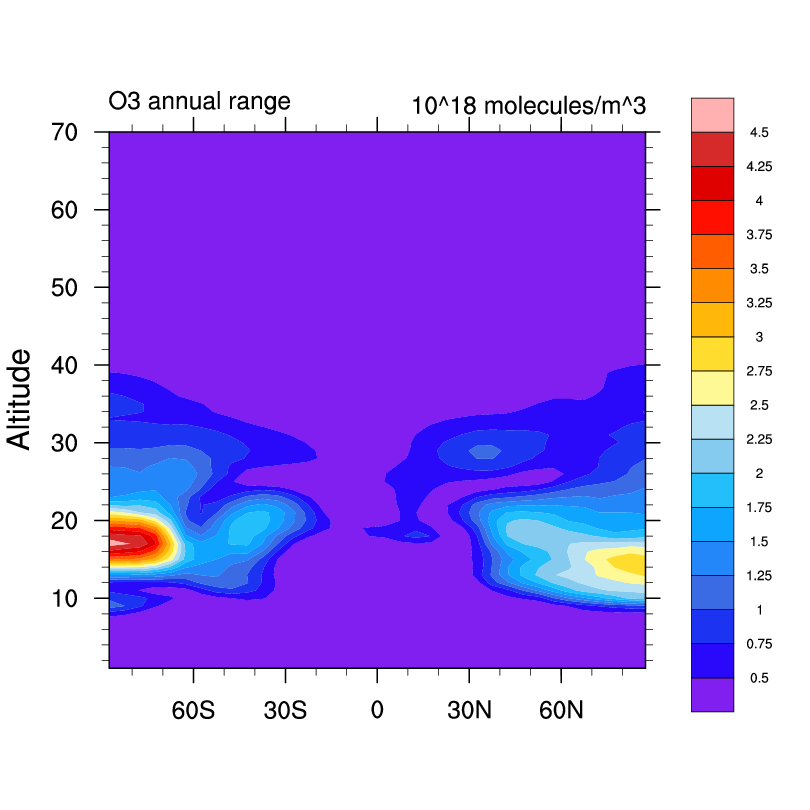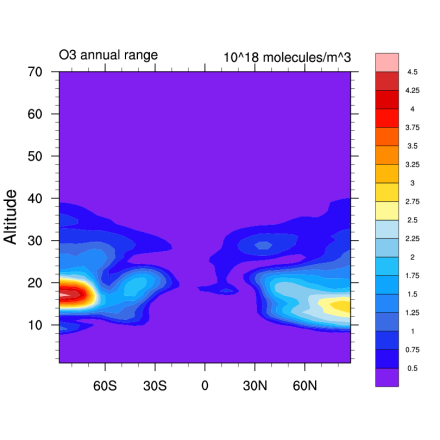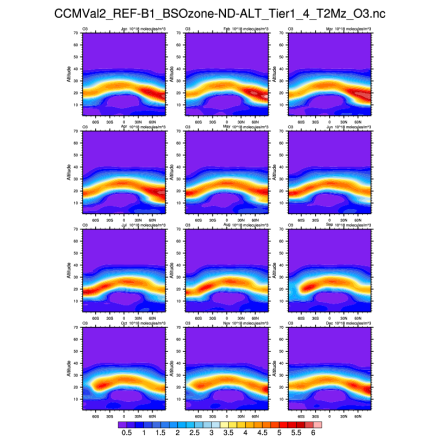Stratospheric Ozone: Vertically Resolved, zonal mean based on BDBP

Combined monthly mean vertical ozone profile database spanning the period 1979 to 2007. The database is completely filled such that there are no missing data. The raw individual ozone data are sourced from the BDBP database. Monthly means are calculated from individual ozone measurements extracted from the BDBP in much the same way as in Hassler et al. (2009). Five "Tier" levels are available: 'raw', anthropogenic, natural, natural + volcanoes, all. The monthly data are zonal and are made available at 70 altitudes (1 km) and pressure levels.
Key Strengths
Key Limitations
Expert User Guidance
The following was contributed by Birgit Hassler (NOAA and CIRES; now at Bodeker Scientific), March, 2013:
The BDBP zonal mean, monthly mean data set is a vertically resolved, gap free ozone data set that spans the period 1979 to 2007. The data set is based on measurements from several different satellite instruments (SAGE I and SAGE II, HALOE, POAM II and III, LIMS, ILAS and ILAS II) and over 130 ozonesonde stations globally. These measurements provide the input for a regression model with which data gaps in the satellite and ozonesonde data are filled to obtain a gap-free data set.
The BDBP data set is available on 70 altitude or pressure levels, spanning the atmosphere from the Earth’s surface up to 70km or ~0.05hPa, and both ozone volume mixing ratio and ozone number density. Although a tropospheric ozone field is included in the data set, the main focus at its creation was the stratosphere. The variability contained in the data set resembles the variability of the observations and is obtained by including a multitude of basis functions in the regression model (Bodeker et al., 2013).
This data set is suitable for assessing ozone fields from chemistry–climate model simulations or for providing the ozone boundary conditions for global climate model simulations that do not treat stratospheric chemistry interactively.#
Cite this page
Acknowledgement of any material taken from or knowledge gained from this page is appreciated:
Hassler, Birgit & National Center for Atmospheric Research Staff (Eds). Last modified "The Climate Data Guide: Stratospheric Ozone: Vertically Resolved, zonal mean based on BDBP.” Retrieved from https://climatedataguide.ucar.edu/climate-data/stratospheric-ozone-vertically-resolved-zonal-mean-based-bdbp on 2025-12-20.
Citation of datasets is separate and should be done according to the data providers' instructions. If known to us, data citation instructions are given in the Data Access section, above.
Acknowledgement of the Climate Data Guide project is also appreciated:
Schneider, D. P., C. Deser, J. Fasullo, and K. E. Trenberth, 2013: Climate Data Guide Spurs Discovery and Understanding. Eos Trans. AGU, 94, 121–122, https://doi.org/10.1002/2013eo130001
Key Figures
Other Information
- Bodeker, G. E., Hassler, B., Young, P. J., and Portmann, R. W.: A vertically resolved, global, gap-free ozone database for assessing or constraining global climate model simulations, Earth System Science Data, 5(1), 31–43. doi:10.5194/essd-5-31-2013.
- Hassler, B., G. E. Bodeker, I. Cionni, and M. Dameris (2009), A vertically resolved, monthly mean, ozone database from 1979 to 2100 for constraining global climate model simulations, International Journal of Remote Sensing, 30(15-16), 4009–4018.
- Hassler, B., G. E. Bodeker, and M. Dameris (2008), Technical Note: A new global database of trace gases and aerosols from multiple sources of high vertical resolution measurements, Atmospheric Chemistry and Physics, 8, 5403-5421.
- Polvani, L.M. et al (2011): Large cancellation, due to ozone recovery, of future Southern Hemisphere atmospheric circulation trends
- B. Hassler, P. J. Young, R. W. Portmann et al (2013), Comparison of three vertically resolved ozone data sets: climatology, trends and radiative forcings, Atmos. Chem. Phys., 13, 5533-5550.
- Solomon, S., P. J. Young, and B. Hassler (2012), Uncertainties in the evolution of stratospheric ozone and implications for recent temperature changes in the tropical lower stratosphere, Geophys. Res. Lett., 39, L17706, doi:10.1029/2012GL052723.

